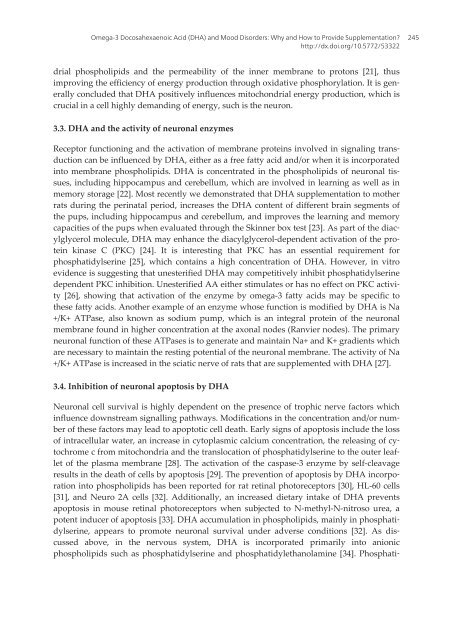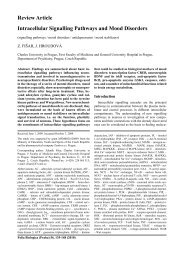MOOD DISORDERS
MOOD DISORDERS
MOOD DISORDERS
You also want an ePaper? Increase the reach of your titles
YUMPU automatically turns print PDFs into web optimized ePapers that Google loves.
Omega-3 Docosahexaenoic Acid (DHA) and Mood Disorders: Why and How to Provide Supplementation?<br />
http://dx.doi.org/10.5772/53322<br />
drial phospholipids and the permeability of the inner membrane to protons [21], thus<br />
improving the efficiency of energy production through oxidative phosphorylation. It is gen‐<br />
erally concluded that DHA positively influences mitochondrial energy production, which is<br />
crucial in a cell highly demanding of energy, such is the neuron.<br />
3.3. DHA and the activity of neuronal enzymes<br />
Receptor functioning and the activation of membrane proteins involved in signaling trans‐<br />
duction can be influenced by DHA, either as a free fatty acid and/or when it is incorporated<br />
into membrane phospholipids. DHA is concentrated in the phospholipids of neuronal tis‐<br />
sues, including hippocampus and cerebellum, which are involved in learning as well as in<br />
memory storage [22]. Most recently we demonstrated that DHA supplementation to mother<br />
rats during the perinatal period, increases the DHA content of different brain segments of<br />
the pups, including hippocampus and cerebellum, and improves the learning and memory<br />
capacities of the pups when evaluated through the Skinner box test [23]. As part of the diac‐<br />
ylglycerol molecule, DHA may enhance the diacylglycerol-dependent activation of the pro‐<br />
tein kinase C (PKC) [24]. It is interesting that PKC has an essential requirement for<br />
phosphatidylserine [25], which contains a high concentration of DHA. However, in vitro<br />
evidence is suggesting that unesterified DHA may competitively inhibit phosphatidylserine<br />
dependent PKC inhibition. Unesterified AA either stimulates or has no effect on PKC activi‐<br />
ty [26], showing that activation of the enzyme by omega-3 fatty acids may be specific to<br />
these fatty acids. Another example of an enzyme whose function is modified by DHA is Na<br />
+/K+ ATPase, also known as sodium pump, which is an integral protein of the neuronal<br />
membrane found in higher concentration at the axonal nodes (Ranvier nodes). The primary<br />
neuronal function of these ATPases is to generate and maintain Na+ and K+ gradients which<br />
are necessary to maintain the resting potential of the neuronal membrane. The activity of Na<br />
+/K+ ATPase is increased in the sciatic nerve of rats that are supplemented with DHA [27].<br />
3.4. Inhibition of neuronal apoptosis by DHA<br />
Neuronal cell survival is highly dependent on the presence of trophic nerve factors which<br />
influence downstream signalling pathways. Modifications in the concentration and/or num‐<br />
ber of these factors may lead to apoptotic cell death. Early signs of apoptosis include the loss<br />
of intracellular water, an increase in cytoplasmic calcium concentration, the releasing of cy‐<br />
tochrome c from mitochondria and the translocation of phosphatidylserine to the outer leaf‐<br />
let of the plasma membrane [28]. The activation of the caspase-3 enzyme by self-cleavage<br />
results in the death of cells by apoptosis [29]. The prevention of apoptosis by DHA incorpo‐<br />
ration into phospholipids has been reported for rat retinal photoreceptors [30], HL-60 cells<br />
[31], and Neuro 2A cells [32]. Additionally, an increased dietary intake of DHA prevents<br />
apoptosis in mouse retinal photoreceptors when subjected to N-methyl-N-nitroso urea, a<br />
potent inducer of apoptosis [33]. DHA accumulation in phospholipids, mainly in phosphati‐<br />
dylserine, appears to promote neuronal survival under adverse conditions [32]. As dis‐<br />
cussed above, in the nervous system, DHA is incorporated primarily into anionic<br />
phospholipids such as phosphatidylserine and phosphatidylethanolamine [34]. Phosphati‐<br />
245






